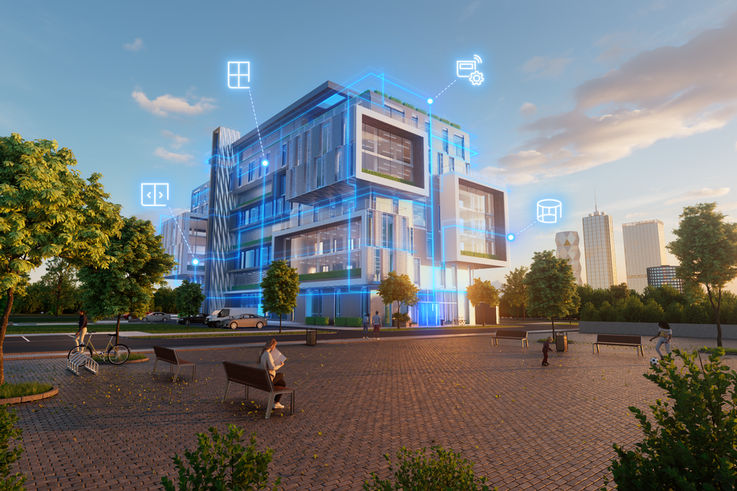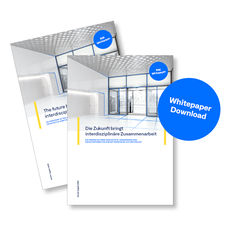Forward-thinking building renovation: how conversion and upgrading can revitalise buildings
Former shopping malls converted to office space, or historically preserved, stately buildings converted into hotels: building renovations show how existing buildings can be revitalised through innovative modifications and modern upgrades, to realise not only their architectural, but also their sustainability and economic potential. GEZE expert Sören Eilers provides tips in an interview for what to take into account in building renovations, and what advantages targeted upgrades and modernisations offer.
First, let’s start by defining some terms: what’s the difference between “building rehabilitation” and “building renovation”?
Building rehabilitation and building renovation differ in their objective and their focus: building rehabilitation is focused on improving the condition and functionality of an existing building. Often, these projects are focused on renovating energy systems to improve the energy efficiency and economic efficiency of an existing building. In building renovation, construction measures intended to adjust the building to new usage requirements are the focus. These include conversions, adding floors or expansions, for example to convert a former office building into a hotel. While building rehabilitation, therefore, focuses on maintaining and optimising the existing building, renovations are more about making structural changes and adjustments to fit changing usage requirements.
Which specific challenges are there when changing the use of a building, for instance when converting an office building into a hotel?
When converting rooms or entire buildings, upgrading can improve the functional versatility of the building and make it possible to use the existing building structure more efficiently. When an office building is converted into a hotel, for instance, the door and window technology, as well as the building automation need to be adjusted to the new use of the building, in order to meet changing requirements resulting from user needs. In addition, construction law specifications like universal access and fire protection must also be taken into account when converting a building.
Can you explain the construction law specifications to be observed in building redevelopment in more detail?
Building renovations are an interesting challenge for architects and building operators: they begin by taking stock of and evaluating the building, followed by feasibility studies and a concept development phase. Legal framework conditions such as specifications under construction law, and in some cases historical preservation requirements must be taken into account. Building operators, in particular, must comply with a wide range of accessibility requirements and specifications under building law. In addition to the basic specifications required under DIN 18040, more and more operators are required to observe workplace regulation ASR V 3a.2. These regulations not only ensure the safety of and accessibility for all users, they also regulate potential legal consequences and liability risks for operators. Therefore, compliance with the accessibility specifications of DIN 18040 is an important aspect in many renovation and upgrade projects.
Do these construction law specifications and standards also pose challenges for installation companies, for example who are upgrading doors with new door systems?
Yes, of course. Installation companies need to ensure the new door systems are functional, safe and fulfil regulations, while at the same time respecting the specifications for the existing building. Because of this, we support installation companies when choosing door systems that are compatible with existing building materials and structures and that, for instance, fulfil specifications for fire protection or accessibility.
Does the level of accessibility required by law in public buildings also result in synergy effects?

Efficient and secure building automation and control system for GEZE products © GEZE GmbH
Of course, because accessibility also brings with it a range of other advantages, both for building users and building operators: automatic doors and windows allow for effortless operation and therefore added comfort, not only for people with limited mobility, but also for all other users as well. That means people can pass through automatic doors easily, even with a stroller, luggage, or just with full shopping bags.
And automated windows activated without requiring force make it easier to ventilate. If automated windows are also integrated into the building management system, then ventilation behaviour, indoor air quality, and energy efficiency can be optimised. These measures make the building not only more inclusive, but also more attractive for a broader group of users – while increasing the value of a property.
To what extent can investments in modern door, window and technical building systems increase the market value of a building?
A building that conforms to current technical standards, while meeting current expectations for comfort and safety, is much more attractive on the real estate market. It is more likely to appeal to potential buyers and renters, and can fetch better rental or sales prices.
What are the concrete advantages of upgrading existing buildings with modern door and window technology?
In the case of building renovations, upgrading door and window technology and building automation and control systems offers a multitude of advantages going beyond just meeting statutory requirements. They increase safety and comfort for all users, contribute to more efficient building operation and more sustainability, and also increase the value of the building. Because of this, it pays off for architects and building operators to invest in innovative technologies and to renovate and convert existing buildings accordingly.
- One key advantage of these modernisation measures is their modular design. These systems can usually be upgraded relatively easily – even if there were no pre-installations previously. This means existing buildings can be updated to make them state-of-the-art step-by-step.
- Modern drive technology is not only lower-maintenance, but also offers much better operating convenience. This can lead to significant improvements especially when changing how a room or building is used.
- Another key point is that modern systems are more sustainable. They reduce both the time and cost required for maintenance. In addition, they deliver better energy efficiency, which leads to long-term operating cost savings.
Questions about modernising building technology?
Retrofitting and modernising existing buildings offers many advantages and we have the solutions for window, door and security technology. Our experts will be happy to advise and support you with your challenges.
Get in touch with us on +49-7152-203-113.
Can you give us an example to explain how upgrading to modern technical building systems can improve the energy efficiency, and therefore the operating costs of a building?

Energy-efficient indoor climate through controlled natural ventilation using window drives from the IQ windowdrives series.
Often, installing smarter and more automated systems can result in significant savings in terms of energy consumption. One example are modern automatic doors that avoid heat loss through efficient opening and closing. So-called vestibule systems – which have two automatic doors arranged in a series – are optimal in entrance areas. This interlock principle keeps the interior temperature stable, while at the same time preventing dirt from getting inside the building. This not only reduces heating costs, but cleaning as well.
There are also promising ways to improve efficiency in terms of windows as well: window drives with intelligent sensors allow for needs-based, automated ventilation. This is the optimal way to regulate room temperature and air quality, which is usually more efficient than manual ventilation and which reduces heating costs in the winter by reducing heat loss.
Another efficient method for improving the climate in a building, while at the same time saving energy, is automated night-time cooling: in this case, electrically activated windows are used to guide collected heat outside during the night – simply using natural drops in pressure, and without any additional energy.
Overall, it is clear that targeted upgrades using modern technical building systems have an enormous potential to improve energy efficiency, and thereby lower operating costs. Major effects can be achieved with comparatively low investment costs. In this way, existing buildings can be made fit for the future.
GEZE is your contact for all questions related to “forward-thinking building”
Would you like to revitalise your existing building, and are looking for a custom solution for your project? GEZE supports specialist planners and architects with planning and implementation, as well as in building operations, and offers comprehensive project advising in the door, window and safety technology areas.
Contact our GEZE experts using the Architect hotline: +49-7152-203-112
Go to the contact formThinking about the future: what role does sustainability play in terms of building renovations?

The Kö-Bogen II, with Europe's largest green façade, and the Schauspielhaus are impressive landmarks in the centre of Düsseldorf. © Jürgen Biniasch / GEZE GmbH
At least since the new Buildings Energy Act (GEG) was passed, which regulates energy requirements for new buildings and building renovations, sustainability and energy efficiency play a central role in building renovations – ultimately, all existing buildings in the EU are expected to be climate-neutral by 2050, and even earlier, by 2045 in Germany. That means there is a huge amount of work to be done on new buildings and existing buildings alike.
In our expert discussion, learn how building automation can help implement the requirements of the Buildings Energy Act.
What specific requirements do historical preservation regulations place on renovating existing buildings?
Planned changes to a historically preserved building need to be justified very carefully and extensively. One example is the historically preserved Laiszhalle in Hamburg: in this case, we needed to provide detailed justifications under building law for the structural interventions which were part of the renovation, in order to obtain a permit from the office of monuments. In this case, we were able to combine automated ventilation and smoke and heat extraction systems. The example of the Magdeburg Cathedral shows that creative solutions for bringing together historical preservation and renovation are possible. Instead of complex wiring, in this case we were able to install a wireless extension for fire protection. This saves a significant amount of time and costs, since no complicated wiring was required to the specified ceiling-mounted detectors.
Are there other examples for creative solutions for meeting historical preservation requirements in existing buildings?
When renovating existing buildings, special solutions are often needed. For example, we can design door and window systems or technical building systems in custom colours or installation situations to perfectly adapt them to the historical architecture. These kinds of customised special solutions are used, for example, in the historically preserved Gare de Montreux in Switzerland or the 4-star Hotel and Spa Radisson Blu Malo-Les-Baines in the French city of Dunkirk.
Handling historically preserved buildings in a sensitive way takes a high level of tact and creativity. This is the only way to harmonise historical preservation requirements with the renovation project and find forward-thinking solutions.
How do you approach meeting the needs of planners, building operators and building users all at once?
A comprehensive approach is needed to do so. We recommend early and continuous dialogue with everyone involved. Right from the start, we work to make contact with architects as general managers, building services planners, and other specialist planners. Ideally, everyone involved can be brought together for meetings – although this is not always easy to do in practice. Instead of just asking questions, we feel it is important to clearly address relevant building law and sustainability issues and bring them into the planning process as set target specifications. These include, for example, energy standards, regional fire protection requirements, or accessibility requirements.
Through this proactive approach, potential conflicts can be identified in advance and solutions can be developed together. This is the best way to take the needs of everyone involved into account and transfer them into a harmonious overall concept.
Our expert tip:
Use BIM (Building Information Modelling) when renovating existing buildings.
By using BIM in building renovations, architects, planners and building operators can benefit from optimised planning, more efficient construction processes, and smoother communication. The biggest advantage is that available data is recorded digitally and updated in real time, helping to avoid outdated or imprecise plans.
Since different specialist plans, such as the architecture, structural planning, building services, etc. can be combined and coordinated in a single model, BIM software can identify potential conflicts between different trades early on and provide suggested solutions.
This improves the quality of building projects, reduces costs, and results in a more sustainable use of existing buildings.
LEARN MORE ABOUT BIM
BIM white paper from GEZE
To learn more about building planning with BIM, download our free white paper!









